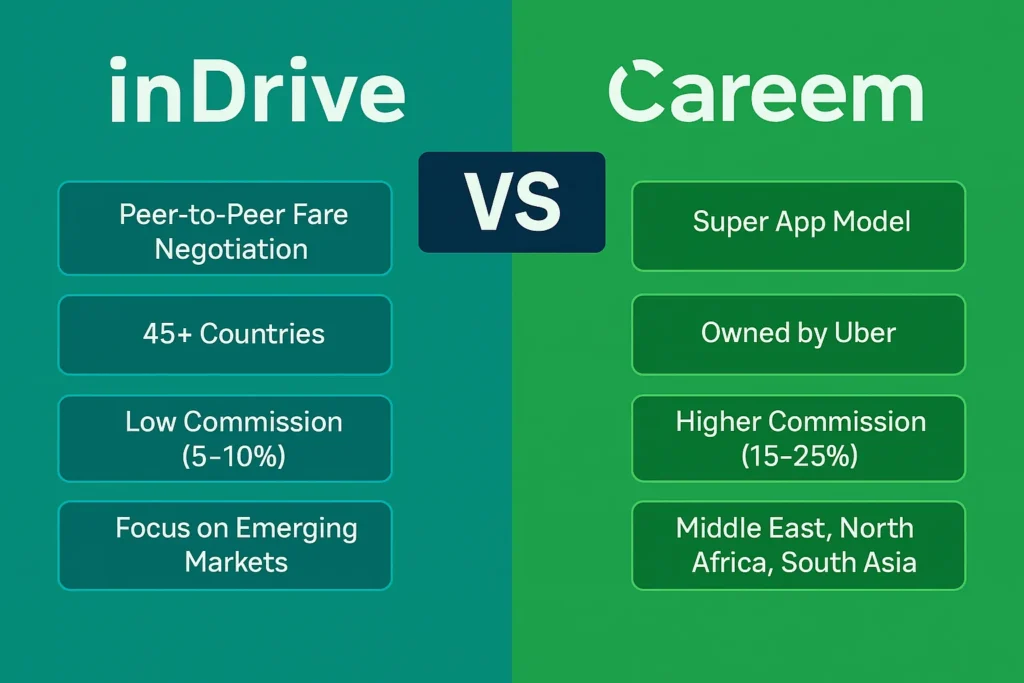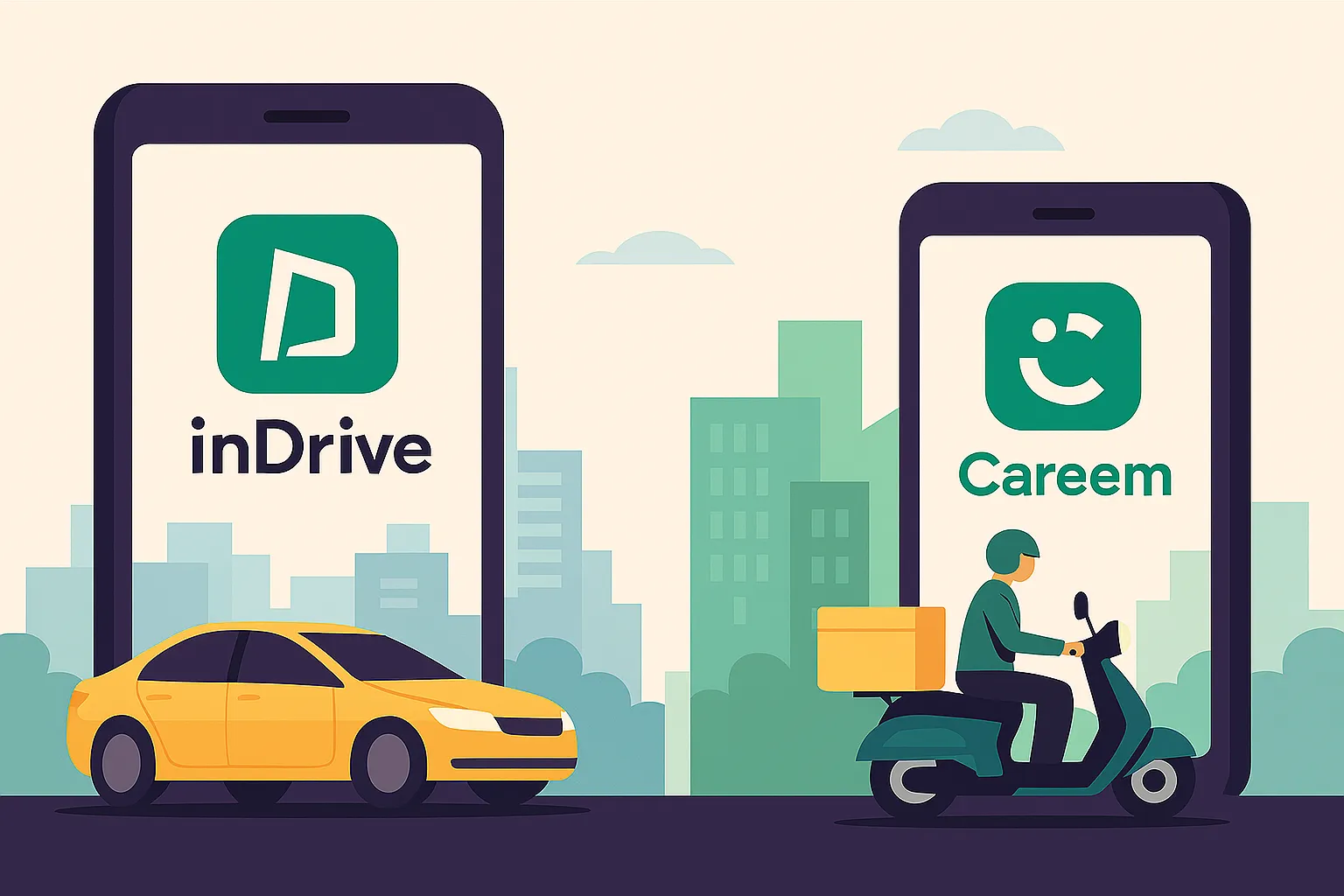As the global ride-hailing industry continues its evolution in 2025, a growing number of entrepreneurs and investors are eyeing mobility as a viable and lucrative startup space. With a focus on regional dominance, differentiated pricing models, and multi-service expansion, apps like InDrive and Careem have set new standards in urban mobility across emerging and developed markets.
While Uber once stood as the global benchmark, today’s market demands localization, innovation, and flexibility. That’s exactly what InDrive (with its unique “peer-to-peer price negotiation”) and Careem (now a super app in the Middle East) are offering.
This blog explores the InDrive business model vs Careem business model, diving into their revenue engines, cost structures, partner ecosystems, and growth strategies. If you’re a startup founder looking to build your own ride-hailing or super app in 2025, this in-depth guide will help you determine which model aligns best with your vision.

What is InDrive?
InDrive (formerly inDriver) is a global ride-hailing platform based in California, USA, with a mission to make mobility fair and accessible. What sets it apart is its peer-to-peer pricing model—passengers suggest a price, and drivers either accept, reject, or counter the offer.
Key Features:
- Price negotiation between rider and driver
- Operates in 45+ countries
- Focus on underserved and developing markets
- No fixed fare algorithm
- Also provides delivery, intercity rides, and courier services
Tagline: “People Driven.”
Positioning: InDrive is the anti-Uber—community-driven, flexible, and focused on empowering both sides of the transaction.
What is Careem?
Careem, based in Dubai, UAE, started as a ride-hailing service in 2012 and has since evolved into a super app offering services like ride-hailing, food delivery, payments, bike rentals, and more. In 2020, Uber acquired Careem, but it continues to operate independently in the Middle East, North Africa, and South Asia (MENASA).
Key Features:
- Ride-hailing (car, bike, tuk-tuk, etc.)
- Food and grocery delivery
- Digital wallet and peer payments (Careem Pay)
- Multi-service super app model
- Subscription service (Careem Plus)
Tagline: “Everything you need, now in one app.”
Positioning: Careem is the regional super app champion of the MENASA region with a diversified portfolio beyond transportation.
Business Model of InDrive
Revenue Streams
- Commission per Ride: Low commission compared to Uber or Bolt (~5–10%).
- Delivery Fees: Earnings from parcel and courier services.
- Intercity Rides: Charges on long-distance peer-to-peer trips.
- Subscription (Pilot in Some Regions): Testing driver-tier membership perks.
- In-App Ads: Emerging monetization stream in growing markets.
Cost Structure
- App development and maintenance
- Customer support and dispute resolution
- Compliance and city-level partnerships
- Local marketing and driver onboarding
- Scaling customer service and regional teams
Key Partners
- Local governments and transport authorities
- Driver recruitment agencies
- Payment gateways in local currencies
- Community advocacy groups
Growth Strategy
- Expand into underserved cities with no Uber presence
- Hyperlocal campaigns for driver acquisition
- Transparent pricing appeal in inflation-hit markets
- Low commission pitch to win drivers from competitors
Learn More: InDrive App Features: What Sets It Apart
Business Model of Careem
Revenue Streams
- Ride-hailing Commission: Per-trip cut (15%–25%)
- Delivery Charges: Food, groceries, and courier deliveries
- Careem Pay: Transaction fees, wallet services, and bill payments
- Careem Plus Subscription: Monthly fee for discounts and perks
- B2B Logistics: Offering fleet and mobility solutions to businesses
- In-App Advertising and merchant promotion revenue
Cost Structure
- App infrastructure and backend systems
- Customer support for multi-services
- Delivery partner commissions and incentives
- Local logistics operations and warehousing
- Loyalty programs and cashback offers
Key Partners
- Restaurants, pharmacies, grocery stores
- Banks and fintechs (Careem Pay integration)
- Local logistics providers and warehouses
- Government regulators and municipal transport authorities
- Uber (parent company)
Growth Strategy
- Building Careem as a multi-service lifestyle platform
- Geographic focus on MENASA expansion
- Integration of AI and ML for routing and personalization
- B2B fleet-as-a-service growth
Learn More: Create a Powerful Careem Clone App – Fast & Easy Guide
Comparison Table: InDrive vs Careem
| Feature | InDrive | Careem |
| Founded | 2013 (Russia origin, now global HQ in USA) | 2012 (UAE) |
| Core Model | Peer-to-peer fare negotiation | Super app with ride + delivery + fintech |
| Commission | 5%–10% | 15%–25% |
| Super App? | No | Yes |
| Geographic Focus | Emerging and developing nations | Middle East, North Africa, South Asia |
| Parent Company | Independent | Owned by Uber (since 2020) |
| Tech Stack | Lean, regionally adaptable backend | Robust, scalable for multi-vertical use |
| User Base | 150M+ downloads globally | 50M+ users in MENASA |
Pros & Cons of InDrive’s Business Model
Pros
- Lower commission attracts more drivers
- Transparent pricing fosters rider loyalty
- Agile and fast launch in new cities
- Empowers riders with price control
- Works well in inflation-affected economies
Cons
- Lack of fare predictability can deter some users
- No luxury or fleet-based options
- Not suitable for premium or high-end markets
- Revenue scaling is slower without subscription power
Pros & Cons of Careem’s Business Model
Pros
- Multiple income streams (rides, delivery, fintech)
- Super app provides long-term retention
- High revenue potential via Careem Pay and Plus
- Regional brand loyalty in MENASA
- Scalable across services and cities
Cons
- Higher operational complexity
- Commission-heavy model risks driver churn
- Needs high capital for tech and logistics
- Heavily regulated in many regions
Market Data: Growth, Revenue, Funding (2025)
InDrive (2025)
- Estimated Revenue: ~$300M
- Downloads: 150M+
- Countries Operated: 45+
- Key Regions: LATAM, South Asia, Africa
- Growth Focus: Peer-driven expansion in Tier-2/3 cities
- Recent Milestone: Launched in 10 African cities in 2024
Careem (2025)
- Estimated Revenue: ~$800M–$1B
- Active Users: 50M+
- Key Regions: UAE, Egypt, Pakistan, Saudi Arabia
- Super App Revenue Split:
- Rides: 60%
- Delivery: 25%
- Payments & Others: 15%
- Recent Expansion: Super app push in Pakistan and Iraq
Which Model is Better for Startups in 2025?
It depends on your market, capital, and scalability plan:
- Choose InDrive-style if you’re entering cost-sensitive markets, prefer low capex, and want to quickly test ride-hailing MVPs.
- Choose Careem-style if you’re planning a multi-vertical super app, have the capital to scale operations, and aim to own lifestyle logistics.
Choose InDrive-Style If…
- You want to enter emerging markets fast
- Your product focus is community and fairness
- You need to avoid high commission backlash
- You prefer a lean launch with driver-first focus
Launch Your Own InDrive Clone Development with Miracuves
Choose Careem-Style If…
- You aim to build a super app in MENA, South Asia, or Africa
- You plan to integrate delivery, payments, and ride services
- You’re targeting a larger urban lifestyle user base
- You have logistics and marketing muscle to scale fast
Launch Your Own Careem Clone Development with Miracuves
Conclusion
InDrive and Careem represent two successful but distinct paths in the ride-hailing and mobility ecosystem. Whether you choose InDrive’s peer-powered model or Careem’s multi-service super app, your choice should align with your target geography, growth goals, and monetization vision.
At Miracuves, we offer white-label clone solutions for both models—customized for your market, user type, and growth roadmap. Let’s help you build the next big mobility platform.
Launch smarter, faster, and better with Miracuves.
FAQs
1. What makes InDrive different from traditional ride-hailing apps?
InDrive lets riders and drivers negotiate fares directly, offering a peer-driven pricing model instead of algorithmic fare calculation.
2. Is Careem still owned by Uber? 2. Is Careem still owned by Uber?
Yes, Uber acquired Careem in 2020, but Careem continues to operate independently in the MENASA region.
3. Which model is better for low-budget startups?
InDrive’s model is more lean and scalable for early-stage startups in emerging markets due to its low commission and simple UX.
4. Can I launch a Careem-style super app without ride-hailing?
Yes! Many founders start with food or payment services and later expand into rides — Miracuves’ Careem clone supports modular launches and scalability, all starting at just $2899.
5. Does Miracuves offer complete clone scripts?
Absolutely! Miracuves provides ready-to-launch InDrive clone and Careem clone apps with full tech stack, admin panel, and custom branding.








